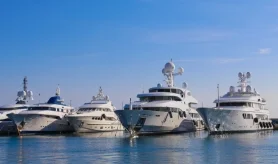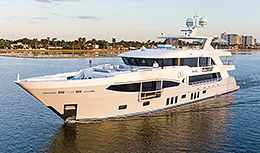- Alaskan Yachts
- Azimut Yachts
- Back Cove Yachts
- Beneteau Yachts
- Benetti Superyachts
- Bertram Yachts
- Boston Whaler
- Broward Yachts
- Buddy Davis Sportfish
- Burger Yachts
- Cabo Yachts
- Catamarans
- Carver Motoryachts
- Center Console
- Chris-Craft Yachts
- Cruisers Yachts
- DeFever Trawlers
- Dufour Sailboats
- Fairline Yachts
- Feadship Yachts
- Ferretti Yachts
- Formula Yachts
- Fountaine Pajot Cats
- Grady-White
- Grand Banks Trawlers
- Hargrave Yachts
- Hatteras Yachts
- Hinckley Picnic Boats
- Horizon Yachts
- Hydra-Sports
- Intrepid Boats
- Jarrett Bay Sportfish
- Jeanneau Yachts
- Kadey-Krogen Trawlers
- Lazzara Yachts
- Lekker Boats
- Luhrs Sportfish
- Marlow Yachts
- Maritimo Yachts
- Marquis Yachts
- McKinna Motoryachts
- Meridian Yachts
- Midnight Express
- MJM Yachts
- Mochi Craft
- Neptunus Motoryachts
- Nordhavn Trawlers
- Nordic Tugs
- Numarine Yachts
- Ocean Alexander Yachts
- Offshore Yachts
- Outer Reef
- Oyster Sailing Yachts
- Pacific Mariner Yachts
- Palmer Johnson Yachts
Superyachts: Art on Board
Learn how art experts and Susan Almrud, Valentina Zannier, and Pascale Reymond integrate art, architecture, and aesthetics on some of the world’s largest superyachts.
This article was written by Jill Bobrow. Photography courtesy of the designers.
Owning a superyacht is tantamount to having a second or third home.
So naturally the interior design and décor of a yacht not only reflects the way you live aboard, but your aesthetic sensibilities as well.
And while art and interior architecture are often intertwined, the topic of what art is and what makes art good is a centuries-old conversation with no clear definition. So, understanding art is, at once, universal and personal.

Meanwhile, superyachts are often filled with priceless art even though choosing and placing art on a yacht is not as easy as simply hanging a painting on a wall. The question is: how do superyacht designers and art experts help clients make such personal choices that help make their yacht the ultimate expression of their passion? I spoke to a professional art advisor and two prominent yacht designers to find out.

Susan Almrud is the founder and principal in SA Art Partners, a New York/London-based art advisory that specializes in museum-level modern and contemporary art. She partners with clients newly interested in collecting art as well as enhancing the collections of long-time art lovers.
Almrud’s specific field of expertise is post-war contemporary art. She says, “Most of my clients have been new to collecting. It is very motivating and inspiring to share and expose people to new art and ideas. I never want to force a client to get something he or she does not like, but pushing the envelope a bit is part of the process. Passion for art is essential and this takes time and knowledge to develop.”
All of her collectors have been pleased with how their acquisitions have also increased in monetary value. Almrud says, “There is a Picasso quote that always resonates. He would often say: ‘I do not seek, I find.’” She adds, “Something clicks with me. I sense when I have discovered the right piece for a client.”
I feel more like a connector than someone just selling art.

Her process of working with clients is personal. She says she needs to understand each client’s aesthetics to find out about their current tastes and where they can go. “Often chosen artworks for clients are based on intuition and gut instincts.” After developing some knowledge about those she works with, the most important thing is to gain a client’s trust around choices. Part of the journey of establishing a collection for a client is sharing in-depth information about art. She says, “I like to get people to step outside their comfort zone of what they know. I find sharing art books is a very visual way to inform them about artists with whom they may not be familiar. Once you learn about an artist and their intentions, it helps to understand more about their work. My focus is always on artists with longevity and works with beauty and quality.”
One of Almrud’s superyacht collections was for Lukas Lundin, the now-deceased previous owner of the award-winning Feadship Savannah. “I worked of the specifications and plans of the yacht together with Lukas and with the yacht’s designer, Cristina Gherardi of CG Design, for several years preconstruction. We collected many iconic artworks for the yacht.”
There is no question that the carefully curated art as well as each placement aboard Savannah are enhancements to the overall ambiance onboard. Entering the yacht from the aft main deck, one of the first pieces of art is the epic Cecily Brown mosaic swimming pool installation. Once inside the yacht, unique works by Jim Hodges, Raymond Pettbon, Gerhard Richter, Ugo Rondinone, Ed Ruscha, Andy Warhol, and others, all add to the exquisite interior spaces created by Cristina Gherardi and are part of Savannah’s magical appeal for visitors and guests.

Valentina Zannier is the principal of Valentina Zannier Interiors Architecture studio and has always taken an artistic approach to interior architecture. “I grew up in Venice and art was everywhere,” she says. “In my family, art was truly our daily bread.” As a trained architect, she says that her approach to going granular with design details is to first envision a yacht in its entirety. Her furnishings, such as light fixtures, dining tables, dressers, staircase surrounds, and wall hangings, have one thing in common: “Each and everything I create is unique.”
As former chief of interior design and partner at the renowned design firm Nuvolari Lenard, Zannier made her mark on an impressive roster of yacht projects over a period of more than two decades. One of her most recent projects while at Nuvolari Lenard was the 115-meter Ahpo, where she developed many unique interior features.
“I respect the old masters and I would never equate my artistic creations with them.”

However, I do believe there is a connection between decorative furnishings and fine art. I have always endeavored to push the boundaries between the two.
Zannier is quick to give credit to design companies with whom she collaborates, such as LIST, Based Upon, DKT, and many others.
“Working with shipyards, interior builders, and, of course, artists, I have had the opportunity to cross some lines of art and artistry that I didn’t think possible,” says Zannier. “Together we have developed a language that integrates joinery details into special surfaces and the final result looks like art just not the type of art you hang on the wall, or that stands on a pedestal.”

Pascale Reymond, partner in UK-based Reymond Langton Design, says, “Having studied art and art history at university, I was an artist before being a yacht designer. A work of fine art is more than the sum of its elements the whole has its own magic, totally unplanned, and does not try to match or compliment anything. Fine art is full of surprises.”
Reymond goes on to say, “Design and integrated art are very different and, to an extent, very much planned and controlled. They have to sit in their dedicated environment that the owner or designer has allocated. There is not very much room for spontaneity. To be a true work of art, you need to let the creator breathe and give him space as even the artist himself cannot necessarily control the final product. It could be a terrible work of art or a piece of magic.”

Many Reymond Langton-designed yachts enjoy a large proportion of integrated art in all areas of the yacht interior. They commission many different artists and artisans, such as leather carvers (Bravo Eugenia saloon), handwoven silk tapestry (Artefact VIP stateroom), and painted and embroidery panels (staterooms in H3 and Aviva).
“While we engage artists from all over the world to collaborate with us, we always direct them,” says Reymond. “We have a multi-talented and artistic team at Reymond Langton.
With my background in fine art, I not only enjoy and can paint, I also have a seriously great passion for art.
I have personally collected over 70 paintings in the last 20 years.”

It is always a fine balance in an interior to have integrated art working well with an existing art collection. Integrated art is usually more in line with interior design while independent paintings are collection pieces which have a life of their own and history behind them, and do not serve the purpose of decoration. “A good balanced interior should have both,” says Reymond.
In the end, many superyachts themselves embody art and artistry. Adjectives used to describe yacht’s profiles, hulls, and superstructures are often similar to the language of art: linear, sculptured, balanced, proportional, monochromatic, smooth, uniform, symmetrical, asymmetrical, glossy, refective, edgy, precise, and so on.

Request a Copy






